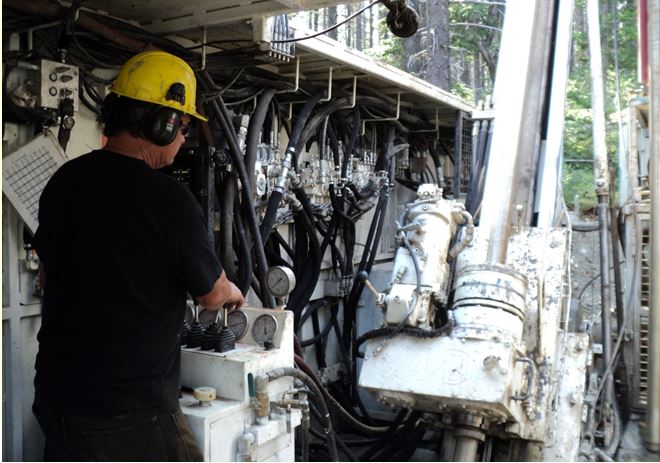Serengeti drills 2.0 g/t gold Eq over 438 metres at Kwanika Central Zone


Serengeti Resources Inc. [SIR-TSXV; 34S-FSE] reported results of a recently completed drilling program on its Kwanika copper-gold resource-stage project located in the Quesnel trough northeast of Smithers, northern British Columbia.
Three holes were completed totaling 2,446 metres, and included an intercept of 438 metres grading 0.71% copper, 0.83 g/t gold and 2.0 g/t silver (2.0 g/t gold Equivalent & 1.25% copper Equivalent) within the Kwanika Central Zone resource shell. The second hole intersected a broad, gold anomalous interval within highly altered andesites potentially lying above a separate buried mineralized centre, approximately 500 metres to the north. The third and deepest hole essentially ended in copper-gold mineralization on the northwest edge of the central zone, indicating the system appears to be increasing in grade and remains open to depth in this direction.
Drill hole K-177 was designed to test: (a) the up-dip and down-dip edges of the central zone, (b) test for lateral continuity of the monzonite-hosted, supergene-enriched copper zone that caps the deposit, and (c) assist in resource modelling and future definition drilling of the central zone. K-177 met all these objectives and encountered some of the highest grades intersected in the zone to date, for instance: 19.04% copper and 6.52 g/t gold over 3.6 metres within a 233.6-metre interval grading 1.18% copper and 1.3 g/t gold.
“This is an exceptional hole, one of the best we have drilled at Kwanika and demonstrates the very high copper-gold grades present within the central zone. Because it was drilled perpendicularly to virtually all the other holes in the deposit, it also provides a host of new geological information,” stated Serengeti President and CEO David W. Moore, P.Geo.
Drill hole K-178 tested a large deep IP (induced polarization) chargeability anomaly approximately 500 metres north of the central zone and intersected a broad interval of strongly anomalous gold values within intensely altered andesitic volcanic rocks interpreted to lie above a potentially new mineralized centre, lying within a separate structural block from that hosting the central zone.
“The gold values in particular are similar to those seen immediately adjacent to the central zone in K-177, and along with the local, strong biotitic (potassic) and silica-pyrite alteration noted in K-178, indicate that we may still be above a potentially high-grade mineralized monzonite occurring at greater depth. This hole has provided a strong vector from prior shallower holes in the vicinity and suggests that additional deep holes are warranted testing this target,” stated Moore.
Hole K-178 returned 245.3 metres of 0.06% copper, 0.11 g/t gold and 0.7 g/t silver (0.23 g/t gold Equivalent & 0.14% copper Equivalent).
Hole K-179 returned 58.7 metres of 0.26% copper, 0.29 g/t gold and 1.2 g/t silver (0.73% gold Equivalent & 0.45% copper Equivalent).
K-179, the final and deepest hole of the program, tested the open down-dip northwest edge of the central zone. After traversing a section of Cretaceous cover rock that preserves the supergene copper zone elsewhere in the deposit, the hole cut a long interval of increasingly altered andesitic volcanics with a long interval of increasing copper-gold mineralization at its lower contact with the underlying monzonite. An interval of 0.26% copper and 0.29 g/t gold over 58 metres at the bottom of the hole indicates that the system remains open, and appears to be increasing in grade to depth. The bottom of this current hole lies 75 metres to 100 metres laterally from and well below the two nearest pre-existing holes.
“It is clear that this hole needs to be drilled deeper, perhaps as much as 300 metres to 400 metres, and, had we not been at the limit of the drilling budget, we would have done so,” stated Moore. “We’ve left the casing in this hole, and our first recommendation for the next program will be to deepen this hole and consider drilling some wedge cuts from it.
“We view the 2016 drill program as a great success and look forward to seeing these significant new drilling results, along with our new geological interpretations and modelling parameters, incorporated into the revised resource estimate, which will focus on the heart of the central zone. This work is under way, and, as previously indicated, results from this independent study being conducted by SRK should be available early in calendar fourth quarter,” stated Moore.
The work outlined above is being financed by Daewoo Minerals Canada whereby the partner will earn a 5% project interest by paying Serengeti $400,000 (paid) and spending $800,000 on the project in the first year. Daewoo may earn an additional 30% interest in the project by spending an additional $7-million over the following two years for aggregate expenditures of $8.2-million to earn a 35% interest. Serengeti is operator and is entitled to charge a 10% operator fee on expenditures beyond the initial $1.2-million. Serengeti also maintains the right to enter into precious metal streaming transactions subject to certain off-take rights to Daewoo.
Go to the company’s website to view graphics related to these drilling results at http://www.serengetiresources.com
